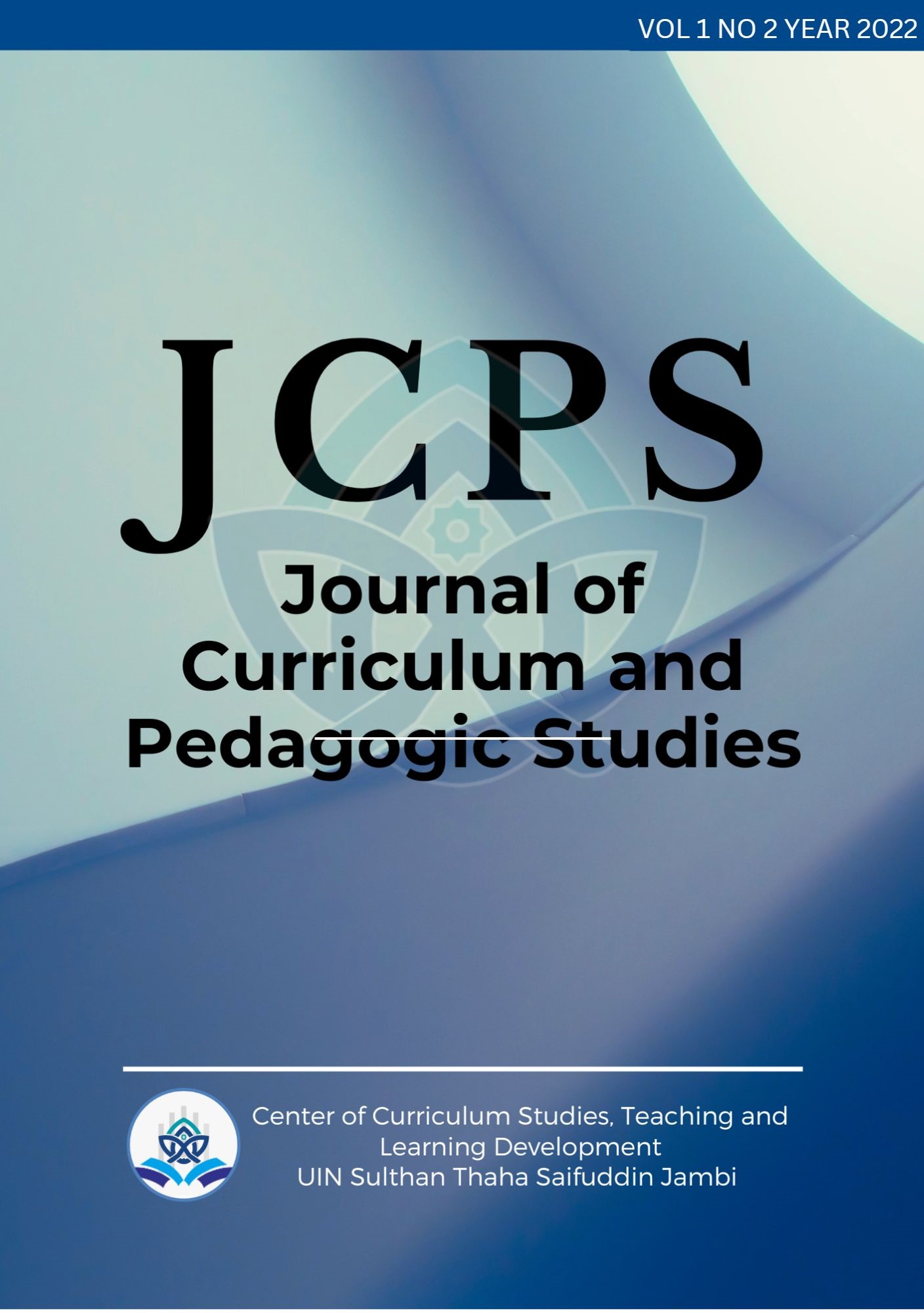Mathematical Communication of Students Who Have Auditorial Learning Styles in Solving Rectangular Problems
DOI:
https://doi.org/10.30631/jcps.v1i2.1633Keywords:
Auditorial Learning Style, Mathematical Communication, Problem Solving, Stage of Creative ThinkingAbstract
Mathematical communication is an important part of mathematics learning. It is important for learners to communicate mathematical problems appropriately so that students can solve these problems. In communicating mathematical problems, students face them with different responses. Students' mathematical communication skills vary due to many factors that affect them, one of these factors is learning style.This study is of a descriptive-qualitative type and aims to describe the mathematical communication of students who have an auditorial learning style in solving rectangular problems. The instruments used consisted of learning style questionnaires adapted from the VAK Learning Styles Self-Assessment Questionnaire, problem solving tests, and interview guidelines. Tests and interviews are conducted for students who have auditory learning styles. Research data were obtained from the results of written tests and interviews that were analyzed based on visual, written, and oral mathematical communication indicators. The results of the study include, (1) SA cannot write a description on the picture in full, (2) SA is able to understand the problem by writing down the information contained in the problem and is able to solve the problem appropriately, but does not write down the formula used, (3) During the interview process SA is able to reveal images according to the problem given and is able to explain verbally the mathematical ideas used in solving the problem.
References
Alfiah, T. ., Rohcmah, U., Madiati, N., & Yahya, Z. . (2021). KALEIDOSCOPE GURU 2021 The Untold Story (A. Wafi (Ed.)). Duta Media Publishing.
Anintya, A, Y., Pujiastuti, E., & Mashuri. (2017). Analysis of Mathematical Communication Skills Viewed from Student Learning Styles in Eighth Grader Students in Learning Resource Based Learning Model. UJME Unnes Journal of Mathematics Education, 6(1), 37–43. https://doi.org/10.15294/ujme.v6i1.13630
Arfah. (2018). Hubungan Kemampuan Komunikasi Matematis dan Kemampuan Pemahaman Konsep Matematika Siswa Kelas X SMAN 1 Bajeng. . . Jurnal Nalar Pendidikan, 6(2), 86–94.
Bradshaw, C., Atkinson, S., & Doody, O. (2017). Employing a Qualitative Description Approach in Health Care Research. Global Qualitative Nursing Research, 4. https://doi.org/10.1177/2333393617742282
Chislett, V., & Chapman, A. (2005). VAK learning style self-assessment questionnaire. 13765810_1/courses/2015_S1NSEA_DAAE2009_OL/Chislett_Chapman_2005_VAK_questionnaire.pdf
DePorter, B., & Hernacki, M. (2015). Quantum Learning. Kaifa.
Dewi, F. K. (2019). Identifikasi tahap berpikir kreatif siswa tingkat SMP yang memiliki gaya belajar visual, auditorial, atau kinestetik dalam memecahkan masalah matematika. Universitas Negeri Malang.
Doyle, L., McCabe, C., Keogh, B., Brady, A., & McCann, M. (2020). An overview of the qualitative descriptive design within nursing research. Journal of Research in Nursing : JRN, 25(5), 443–455.
Hendriana, H., & Kadarisma, G. (2019). Self-Efficacy dan Kemampuan Komunikasi Matematis Siswa SMP. Jurnal Nasional Pendidikan Matematika, 3(1), 153–164.
Khoiriyah, S. (2016). Kemampuan Komunikasi Matematis Mahasiswa Dalam Pemecahan Masalah Kalkulus. Jurnal E-DuMath, 2(2), 202–209.
Lestari, K. E., & Yudhanegara, M. R. (2015). Penelitian Pendidikan Matematika. PT Refika Aditama.
Moussa, N. M. (2014). The Importance of Learning Styles in Education. Institute for Learning Styles Journal, 1, 19–27.
NCTM. (2000). In Principles and Standards for School Mathematics (The Nation).
Özbaş, S. (2013). The Investigation of the Learning Styles of University Students. Online Journal of New Horizons in Education, 3(1), 53–58. http://www.crlt.umich.edu/sites/default/files/resource_files/CRLT_no10.pdf
Papilaya, J. O., & Huliselan, N. (2016). IDENTIFIKASI GAYA BELAJAR MAHASISWA. Jurnal Psikologi Undip. https://doi.org/10.14710/jpu.15.1.56-63
Paridjo, P., & Waluya, S. B. (2017). Analysis Mathematical Communication Skills Students In The Matter Algebra Based Nctm. IOSR Journal of Mathematics, 13(01), 60–66. https://doi.org/10.9790/5728-1301056066
Pourhosein Gilakjani, A. (2012). Visual, Auditory, Kinaesthetic Learning Styles and Their Impacts on English Language Teaching. Journal of Studies in Education, 2(1), 104–113. https://doi.org/10.5296/jse.v2i1.1007
Sandelowski, M. (2010). What's in a name? Qualitative description revisited. Research in Nursing & Health, 33(1), 77–84.
Sari, I. P. (2017). Kemampuan Komunikasi Matematika Berdasarkan Perbedaan Gaya Belajar Siswa Kelas X Sma Negeri 6 Wajo Pada Materi Statistika. Jurnal Nalar Pendidikan, 5(2), 86–92.
Widayanti, E., & Anggraeni, S. A. (2019). Analisis Kemampuan Komunikasi Matematis Siswa Dalam Menyelesaikan Soal Open Ended Pada Materi Aritmetika Sosial Kelas Vii Smp. Transformasi. Jurnal Pendidikan Matematika Dan Matematika, 3(2), 115–128.
Wijayanti, I. D., Hariastuti, R. M., & Yusuf, F. I. (2019). Kemampuan Komunikasi Matematis Siswa Ditinjau Dari Gaya Belajar. Jurnal Inovasi Pendidikan Matematika, 2(1), 68–76.
Zahroh, U., & Asyhar, B. (2014). Kecenderungan Gaya Belajar Mahasiswa dalam Menyelesaikan Masalah Fungsi Bijektif. Jurnal Kebijakan Dan Pengembangan Pendidikan.
Downloads
Published
Issue
Section
License

This work is licensed under a Creative Commons Attribution-NonCommercial-ShareAlike 4.0 International License.
Journal of Curriculum and Pedagogic Studies (JCPS) is published under the terms of Creative Commons Attribution 4.0 International License / Attribution - Non Commercial-Share Alike 4.0 International (CC BY-NC-SA 4.0) This license permits anyone to copy and redistribute this material in any form or format, compose, modify and obtain these materials for any purpose, as long as they give credit to the author for the original copyright.











